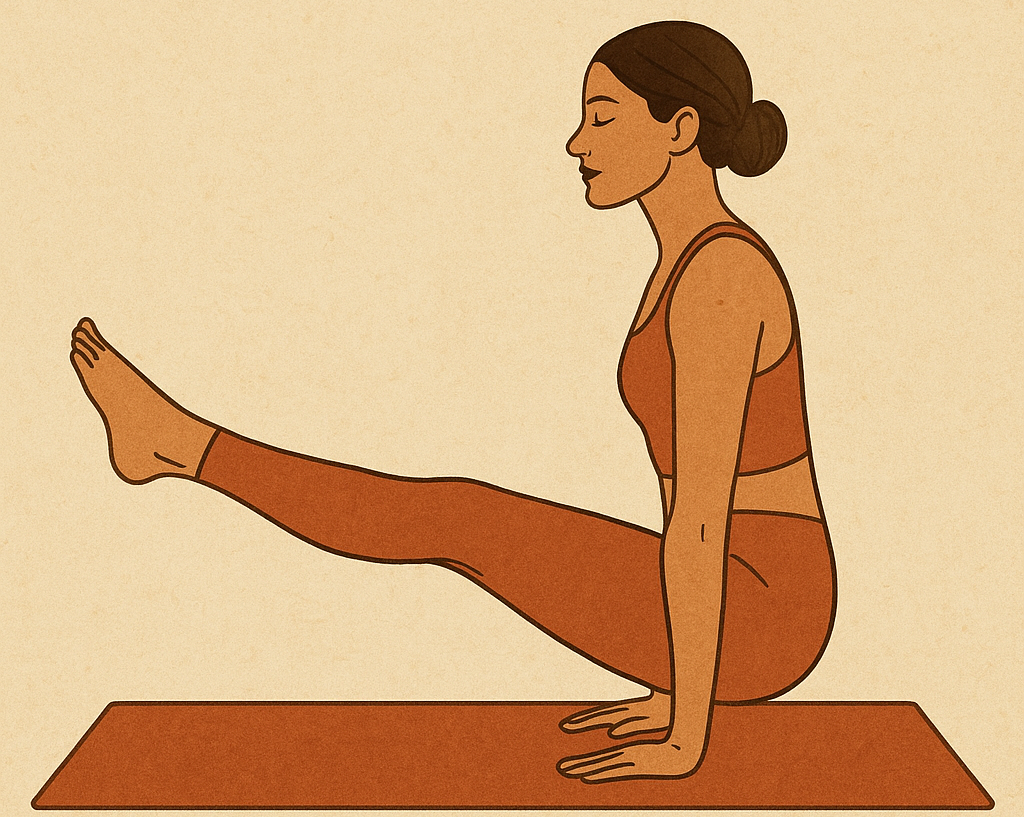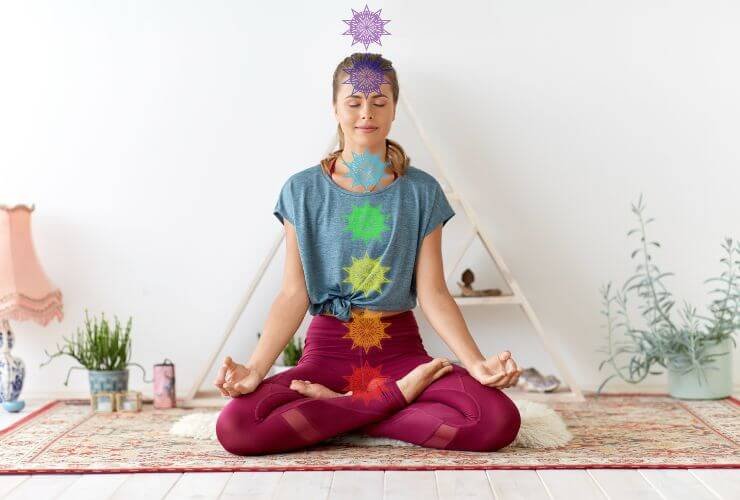Introduction
Lolasana (from lola—to dangle, swing) is an asymmetric arm balance in which the body “hangs” between the arms while the spine rounds and the knees hug in. It builds powerful integration between the core, hip flexors, and shoulder girdle and is often used to prepare for arm balances and smooth vinyasa transitions (e.g., jump-throughs). In contrast to Tolasana (Scale Pose), which stays more upright (usually in Lotus), Lolasana domes the back and widens the shoulders.
How to do Lolasana (step by step)
- Start & hand placement
Kneel and cross one shin over the other (you’ll switch sides later). Place your hands beside the shins, just wider than shoulder distance, fingers spread; root through the whole hand (especially fingertips). - Set the shape
Shift the shoulders forward over the wrists. Round the upper back (think Cat pose), broaden across the shoulder blades, and draw the knees tightly toward the chest. Maintain a slight bend if you tend to hyperextend your elbows. - Lift
Press the floor away to protract the shoulder blades and create space under you; on an exhale, lift the knees and feet off the floor, drawing the heels toward the seat. Keep the gaze slightly forward and the throat neutral. Blocks under the hands make lift-off easier. - Breathe & (optionally) swing
Hold 3–5 slow breaths. You may feel a small rocking/swinging action—stay compact through the knees and steady through your hands. - Exit & repeat
Lower with control, uncross, rest the wrists, and repeat with the other shin on top.
Benefits (what practitioners commonly experience)
- Serious core work: Rectus abdominis and both obliques power the lumbar flexion that rounds (domes) the back and lifts the pelvis; hip flexors assist to hug the thighs in. Expect carryover to jump-throughs and other arm balances.
- Shoulder and arm strength + control: pressing strongly into the floor trains coordinated action of the shoulders and arms, improving stability in Plank/Chaturanga and transitions.
- Proprioception & focus: the compact, suspended shape sharpens attention and steadiness under load.
Anatomy (what’s going on)
- Spine & core: Simultaneous contraction of rectus abdominis, external/internal obliques flexes the lumbar spine and draws the pelvis toward the ribs—this “hollow”/domed action is the engine of lift in Lolasana.
- Shoulder girdle: Strong scapular protraction (think “push the floor away”) is key; the serratus anterior is a primary mover for protraction and helps keep the shoulder blades broad and stable.
- Arms: Elbow extension via triceps; co-contraction through forearm flexors/extensors stabilizes the wrist.
- Hips: Iliopsoas, rectus femoris, and TFL assist the knee-to-chest squeeze that compacts the shape and sustains float.
Preparatory poses & drills
- Load the shoulders: Plank, Chaturanga prep, and Down Dog to pattern pushing and wrist tolerance.
- Core rounding work: Cat (spinal flexion), Knees-to-Chest compressions, Low Boat holds.
- Hip flexion strength: Supine hip-flexor lifts, Chair knee tucks, slow step-ins from Plank (a common progression toward the lift).
- Prop progressions: Practice with blocks under the hands (more room to tuck) or strap the shins/knees lightly to keep legs compact (an Iyengar method).
Contraindications & when to modify
- Wrist, shoulder, or cervical issues / carpal tunnel: Avoid or use props (blocks, parallettes) and regress to forearm-based work until symptom-free.
- Hernia or recent abdominal surgery; pregnancy: Avoid strong compressive lifts; choose supported core work instead.
- High blood pressure, heart conditions, pelvic organ prolapse, or acute low-back pain: Many schools advise avoiding strenuous compressive arm balances; seek individualized guidance.
Red flags: sharp wrist/shoulder pain, finger numbness/tingling, neck strain—stop immediately and regress. (A small, pain-free hover is enough.)
Smart cues & common fixes
- “Push + dome”: press the floor to protract the shoulder blades; feel the upper back round rather than collapsing between the shoulders.
- Compact the shape: hug knees to chest and heels toward seat; smaller ball = easier lift.
- Blocks are friends: if your feet won’t clear, elevate the hands; it’s still Lolasana.
- Mind the elbows: avoid aggressive lockout if you hyperextend—keep a micro-bend and keep pressing evenly through the hand.
Variations
- On blocks or parallettes (more clearance, kinder on wrists).
- Dynamic Lolasana (small, controlled rocks forward/back to explore the “swinging” quality).
- Cross at shins vs. ankles (experiment for comfort and compactness).
Bottom line: Think compact tuck + big push. Keep the scapulae broad, the breath steady, and use props liberally. With consistent technique, Lolasana becomes a powerful bridge to confident, quiet transitions and sturdier arm balances.





